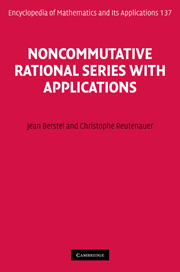2 - Minimization
from Part I - Rational series
Published online by Cambridge University Press: 05 June 2013
Summary
This chapter gives a presentation of results concerning the minimization of linear representations of recognizable series. A central concept of this study is the notion of syntactic algebra, which is introduced in Section 2.1. Rational series are characterized by the fact that their syntactic algebras are finite dimensional (Theorem 1.2). The syntactic right ideal leads to the notion of rank and of Hankel matrix; the quotient by this ideal is the analogue for series of the minimal automaton for languages.
Section 2.2 is devoted to the detailed study of minimal linear representations. The relations between representations and syntactic algebra are given. Two minimal representations are always similar (Theorem 2.4), and an explicit form of the minimal representation is given (Corollary 2.3).
The minimization algorithm is presented in Section 2.3. We start with a study of prefix sets. The main tool is a description of bases of right ideals of the ring of noncommutative polynomials (Theorem 3.2).
Several important consequences are given. Among them are Cohn's result on the freeness of right ideals, the Schreier formula for right ideals and linear recurrence relations for the coefficients of a rational series. A detailed description of the minimization algorithm completes the chapter.
Syntactic ideals
We start by assuming that K is a commutative ring. The algebra of polynomials K ⟨A⟩ is a free K-module having as a basis the free monoid A*. Consequently, the set K ⟪A⟫ of formal series can be identified with the dual of K⟨A⟩.
- Type
- Chapter
- Information
- Noncommutative Rational Series with Applications , pp. 29 - 46Publisher: Cambridge University PressPrint publication year: 2010



